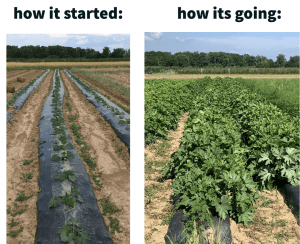Marcus Lopez, Bryan Brown, Abby Seaman
Black plastic mulch is commonly used in vegetable production. Let’s talk about some of the pros and cons. Firstly, black plastic is an extremely effective way to manage weeds. Our plastic mulch plots have almost zero weeds in the rows. In addition to its weed suppression, it also saves many labor hours compared to straw mulch. Soil-borne pathogens are also less likely to come in contact with the leaves of your plants. And, compared with overhead irrigation, leaves stay dry, also reducing diseases. The plastic traps moisture and nutrients, warms the soil, and reduces erosion and compaction as compared to cultivation. Of course, rainfall will not penetrate the soil in these beds, so drip irrigation is a requirement, which makes fertigation an option. In crops with widely spaced planting holes, not benefiting from rainfall is one of the downsides, as well as the obvious equipment and materials required. The plastic layer we used retails for over $5000, which can be a hefty investment for new farms. Brown, Hoshide, and Gallandt (2017) estimated plastic application required about 1.5 hours per acre when using one tractor operator and one general worker. Plastic removal and disposal pose additional costs each year, though some growers can reuse it the following year in crops with similar spacing. And there are photo-degradable plastics available too. Of course, weeds will grow between the plastic rows. This can be combatted by one or two hoeing events or seeding and mowing cover crop.
The bottom line: Black plastic mulch is extremely effective and efficient, but requires a higher initial investment, and generates plastic waste.

Left: 6/29/21 Right: 8/4/21
